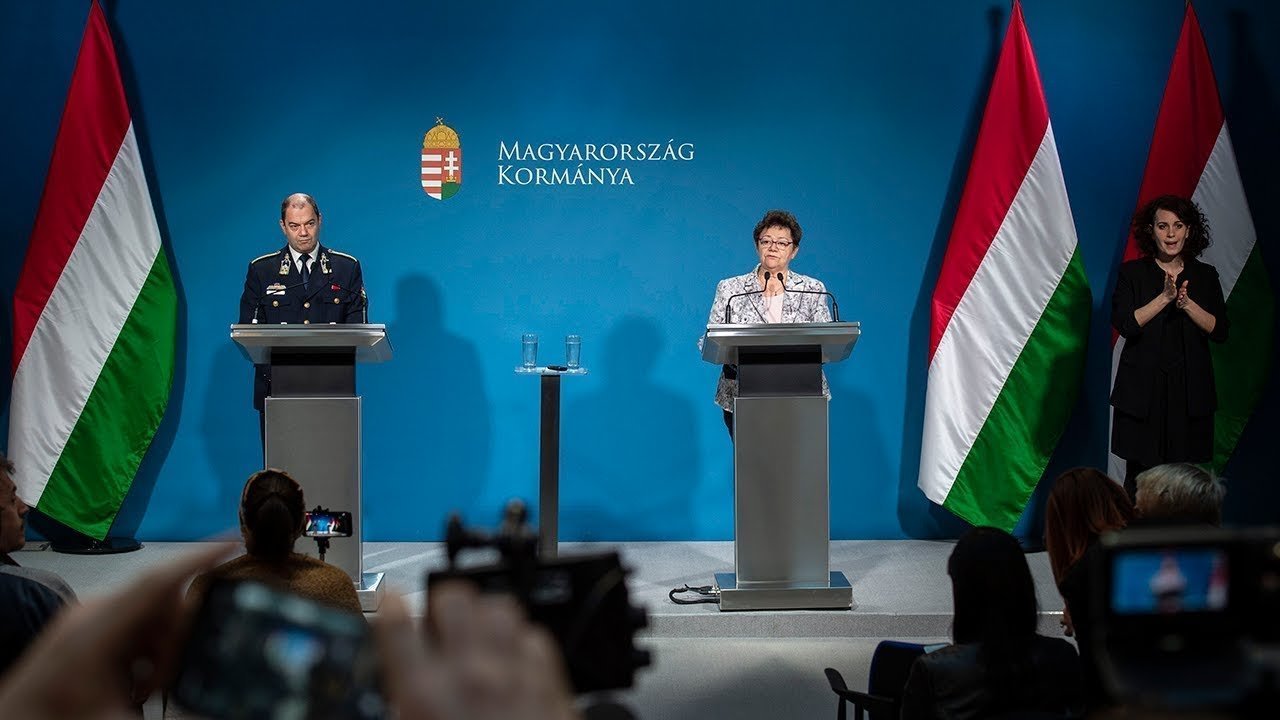After 15 years of constant reorganization, Hungarian epidemiology was hit hard by coronavirus

On March 16, Cecília Müller, the Hungarian Chief Medical Officer announced that they are performing coronavirus tests on everyone who is suffering from pneumonia. This was a wholly new approach compared to the previous protocol that only tested those who had symptoms and had just arrived from a foreign, already infected country or had been in touch with someone who got the virus.
The following case proves how important it is to test as many people as possible. A patient went to the coronavirus center of Szent László Hospital on March 7, but as she did not fulfill the criteria required for a testing she was sent to Szent János Hospital. It was there that it turned out that she had pneumonia and she tested positive for coronavirus as well. By this time, multiple doctors and nurses contacted her without the proper protective gear. Later some of them were quarantined.
Even though the EU’s disease control agency, the ECDC, had suggested to test patients with pneumonia as early as on March, the Hungarian government only applyed this protocol two weeks later, on March 16.
However, testing masses for coronavirus is not easy. Multiple tests must be done for each patient, and right now so many countries are trying to get as many tests as possible that it makes the supply run out quickly. Moreover, the success of the testing depends on how quickly a country can turn over as many laboratories as possible to be able to evaluate the tests.
Epidemiologists and infectologists asked by Direkt36 said that it would be easier to face these challenges if the whole public health and especially the epidemiology system of Hungary had not been restructured back and forth several times by various governments the past 15 years. The process had started during the Gyurcsány government by the privatization of the laboratory network of ÁNTSZ (the National Public Health and Medical Officer’s Service), and continued during the Orbán regime when for one and a half years starting in 2017 there was no efficient public health institution in Hungary whatsoever. In 2018 the government founded the new National Center for Public Health but without of the influence and strength of the previous institution.
The continuous restructuring made many epidemiologists leave their field, and the public health system got much less flexible and can react on a potential epidemic much slower.

PM Viktor Orbán holding a press conferenca about coronavirus. Source: Kormany.hu
We wanted to ask the National Center for Public Health and the operational team responsible for handling COVID-19 about the restructuring of these institutions, and we sent questions to Ferenc Gyurcsány’s current party as well. So far, we have not gotten any answers from either of them.
The fall begins
For a long time after the fall of socialism in 1989 in Hungary, public health system dealing with infectious diseases and epidemics continued to function in the same structure, coordinated by a body known as ÁNTSZ (National Public Health and Medical Officer Service). The reform of the system began under the socialist governments, especially during the premiership of Ferenc Gyurcsány (2004-2009). First, ÁNTSZ’s rural network was restructured: the county-level offices were merged into regional institutions.
At this time, it also came up that ÁNTSZ might not need laboratories in each county. Laboratories carried out bacteriological and viral tests, and also played a role in epidemiological investigations. They were also responsible, for example, for checking the quality of drinking water. The laboratories functioning in ÁNTSZ’ institutions – including 16 microbiological laboratories – were privatised due to the fact that they were making losses, according to the socialist government that was in power.
At that time, the move was criticized by then-opposition party Fidesz. The government is preparing for “murky deals that resemble the era of wild privatization,” the party wrote in a statement in August 2004. According to an article by Népszabadság, the network was eventually sold at the beginning of 2006 for 50 million forints instead of the previously expected hundreds of millions of forints. Later, many of the privatized laboratories were closed down.
Former and current epidemiologists interviewed by Direkt36 felt that the privatisation was a major blow. The decision was
“a disaster. That was when things started to fall apart”,
an epidemiologist talking to Direkt36 on condition of anonymity said, adding that in the previously quick and smooth system it became more complicated to carry out necessary examinations.
We asked László Bujdosó, who was the Chief Medical Officer at that time of the restructuring, whether it had been assessed what impact privatization would have on the system. Bujdosó replied that now it is not the time to point fingers at politicians and decision-makers by bringing up old stories. According to him, now we have to deal with slowing down the spread of the virus, caring for the patients, and protecting the healthy. He promised to answer our questions after the epidemic.
A system split in half
When the Orbán government came to power in 2010, one of its declared goals was to simplify and cut back what they considered to be an oversized and often opaque bureaucratic Hungarian state. To this end, the public administration was reorganized and Government Offices (in every county) were created in 2011. In addition to several other institutions, the regional branches of ÁNTSZ were merged into the Government Offices. As a result, the organization, which had previously been restructured from having county-level to regional-level branches, was forced to undo its recent reorganization.

Source: Kormany.hu
This transformation also meant that the Chief Medical Officer of State lost direct control over the county’s public health institutions, and epidemiology came under the control of politically appointed government officials. According to an epidemiologist with decades of experience, this has caused problems. For example, some counties started to ignore the guidelines of the national epidemiological institute, thinking that
“I can do whatever I want, this is how I think it should be.”
However, the original intention was to have a system where county-level and national institutions closely cooperate for effective disease control measures. According to the source, it was the national headquarters that has gathered the most experience and most information. For example, if they find a rare and serious infectious disease in one of the smaller towns in the country, local officials simply “freeze”. On a county level, probably there is someone who has already seen that disease. But it is the national headquarters where officials actually know what to do and how to act. After the organization was split in half, however, this “hierarchy no longer worked,” according to the source.
The restructuring was also criticized by Judit Paller, the then Chief Medical Officer. “It is very difficult to work with twenty Government Offices,” she told at a conference in February 2011. She said that Hungarian public health institutions had previously been characterized by operating in a well-organized and unified manner, but that was being disrupted at that time.
Health care as a side issue
However, the transformation did not stop here. In 2017 the national organization of ÁNTSZ was restructured as well as part of a package aimed at cutting red tape, a program launched by János Lázár, then the head of the Prime Minister’s Office.
Even after the loss of the county institutions, the ÁNTSZ was a large organization with almost a thousand employees and with an annual budget – according to latest available figures from 2017 – of more than HUF 15 billion (EUR 42.3 million). Within the organization, the National Chief Medical Officer and his office (the National Chief Medical Officer’s Office known as OTH) were in charge of the administration. The chief medical officer also oversaw several national institutes, including the National Center for Epidemiology (OEK).
The 2017 reorganization shook up the system. The position of the National Chief Medical Officer was abolished, and the duties were carried out by a Deputy Secretary of State at the Ministry of Human Resources (EMMI). The epidemic center, OEK, was split: the epidemiological departments merged with the ministry while the laboratory network serving them has been merged into a new institution called the National Institute of Public Health (OKI).
In practice, this meant that colleagues who used to work together had to move to different organizations. What made the collaboration even harder was that the microbiological laboratories and epidemiologists had to start working in different IT systems.
This, according to sources who spent decades in the profession, caused a very serious problem: the flow of information, the linking of epidemiological and microbiological data was difficult. The microbiologist in the lab and the epidemiologic department’s epidemiologist are in many ways interdependent. Their cooperation helps to clarify, for example, whether a patient has received a traditional flu or has been infected by a new coronavirus that causes similar symptoms.
“When these two functions are cut in half, this is the death of this profession,”
said a specialist with decades of epidemiological experience.
The status of those employees who ended up in the ministry changed from civil servant to government official. The latter entails more constraints, government officials for example are not allowed to speak freely in public. “As long as one is a public servant, one does not perceive hierarchical pressure as much. As a civil servant, I felt mentally free,” said one source.
“But being a government official is different,” said one epidemiologist. He felt the space for creative work narrowed: “a government agency works in a way that there is a top-down instruction on what to do, and you are supposed to do it immediately.”
As a result of the reorganization, several people were dismissed, including Viktor Zöldi, an epidemiologist whose division at OEK was split in half. “Just then, I was spending the last months of my foreign scholarship and was about to go back, but I didn’t want to experience what it was like to be a government official at EMMI,” he said. He did not want to work in a ministry where “health care is just one side issue”, referring to the fact that the ministry was in charge of other areas as well apart from health care. He said that it also troubled him that even the leaders of the affected fields were not consulted on the changes.
The professional magazine Epinfo, which had been publishing current data on infectious diseases on a weekly basis for more than two decades, has also been a victim of the changes. The data sets analyzed there had informed general practitioners, hospital doctors, and county epidemiologists on the state of infectious diseases and on what potential epidemics could have been expected in the future. Epidemiologists have repeatedly asked for the magazine to be restarted, but this has not happened yet. As a result, an entire discipline has lost one of its most important forums for communication.
János Lázár, the former minister in charge of the reorganizations, did not respond to Direkt36’s questions.
Taking it all back
One and a half years later, the government took it all back. Epidemiologists asked by Direkt36 said that the government realized that the system was not efficient, so they created a new institution, the National Center for Public Health that was similar to the former ÁNTSZ.
Although it seemed like the government was interested in creating an independent professional institution, by this time many had left the field.
“There was a constant change which was bad for everyone. No one could follow who was who, who was in charge, who we were responsible for – and those things matter a lot”,
said one of the sources when asked why many coworkers left the once again reorganized system.
Besides all these, underfinancing was also an issue. One of the doctors mentioned that it was quite typical that one of the laboratories within the National Center for Public Health network – that for a while was the only laboratory evaluating coronavirus tests – is charging hospitals for non-epidemic clinical tests. The hospitals, however, only receive a certain amount of health insurance money per patient which is not enough to cover the costs of an external laboratory test. Because of this, hospitals are reluctant to submit samples to these laboratories which hinders the identification of other pathogens causing upper respiratory diseases which would be important even when there was no epidemic.
Lack of professional arguments
Epidemiologists and infectologists interviewed by Direkt36 claim that the constant reorganizing led to a weakened public health institute that sometimes handles the pandemic a questionable way or fails to communicate it to the public understandably.

Cecília Müller, Hungarian Chief Medical Officer (on the right). Source: Kormany.hu
Our sources called it inexplicable that NNK refuses to tell gender, age, health state and territorial statistics about the infected. This could help to identify the most endangered population groups and alert people living in certain parts of the country. Zöldi does not understand why the official communication calls it against personal data protection laws to publish basic statistical figures. These figures are regularly released in every other EU countries, even in Russia which is considered much less democratic. According to one epidemiologist, these are the most basic characteristics of any infectious disease. “It doesn’t mean anything if I tell a cumulative number of patients,” the source said.
NNK was repeatedly criticized for not testing enough. While in some countries, widespread testing is considered to be one of the main factors contributing to slowing the spread of the coronavirus, the Hungarian authorities conducted testing in very limited numbers for a long time. According to a specialist, most of the neighboring countries have more confirmed patients than Hungary because they started investigation of the cases earlier. Should the Hungarian authorities have begun widespread testing earlier, the Hungarian mortality rate would be lower now, he added. Although numbers change from one day to another, Hungary’s mortality rate is 3.2 per cent (according to figures from March 28), which is one of the highest among the neighboring countries. In neighboring Slovakia, for example so far there was no victim of the coronavirus epidemic.
According to experts interviewed, the epidemic is a major challenge for most of the countries. A strong public health institution alone would not be enough to overcome this. According to sources, the situation is further exacerbated by the poor state of the Hungarian health care system and the incredible shortage of doctors and nurses.


